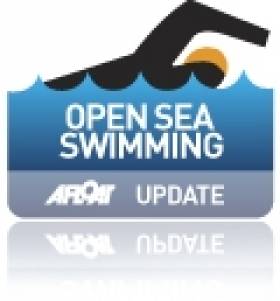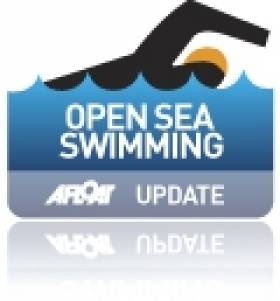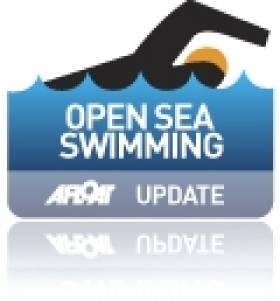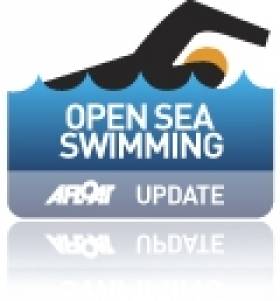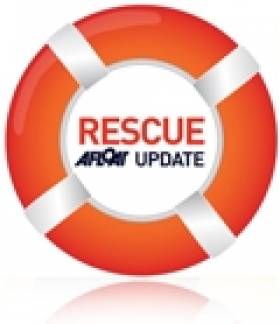Displaying items by tag: Swim
Full Moon Brings Extra Hazard to Swimmers this Christmas
The Christmas season is a time when thousands of people around the country will take to our waters to support sponsored swims for charitable causes say Irish Water Safety. This year we have a full moon on Christmas day which is the first time we have experienced this since 1977 and the next time will be in 2034. This will cause strong tidal streams around our coast and cause rip currents to increase in strength and speed.
Christmas day charity swimmers occasionally take chances beyond what is acceptably safe, finding themselves left without sufficient strength to climb out of the water due to the cold.
Cold winter waters can cause "cold shock" and hypothermia can set in within a short period, especially if there is a high wind chill overwhelming the fittest of swimmers. If sea conditions deteriorate, then the charity swim should be postponed or cancelled. If you see a person in difficulties do not attempt a rescue for which you are not trained. Make use of any nearby public rescue equipment such as a ringbuoy and in the event of an emergency call the emergency services on 112. No alcohol should be taken before the swim and remember to Get in, Get out and warm up.
Charity Swim guidelines:
People organising these swims on Christmas Day, St. Stephen's Day or New Year's Day should ensure that they provide comprehensive details of each event to the Irish Coast Guard and local Gardai.
Each event should have a Safety Officer appointed, who will advise those concerned on safety and have the ultimate responsibility for making decisions in relation to the swim being on or off on the day.
If the seas are rough and weather deteriorates, they should defer the event to a more suitable day without question - if in doubt do not take a chance on running the event.
Many participants will not have swum since the summer and the temperature of the water has now dropped considerably. It is a fallacy that alcohol will keep you warm when entering the water; in fact it has the reverse effect and could kill you. Irish Water Safety strongly recommends that no alcohol be taken either before the swim or after the swim and also remind people that they may be in breach of the drink driving laws when driving to or from the event.
Cold water can cause cold shock and hypothermia in minutes, because the temperature of the water at this time of year will be below 7° Celsius in Fresh Water and 12° Celsius in Seawater.
Ensure that you have safe access and egress with appropriate shallow shelving beaches, steps, slipway or ladders as appropriate. Elderly people should be mindful that steps leading into the water might be dangerous due to the increased growth of algae in wintertime. Organisers must ensure that they have had the access and egress cleaned in advance of the swim to avoid slips and falls.
Fancy dress outfits can seriously impair your ability to float - please do not wear when swimming.
Swimmers' remaining in the water for extended periods in a gesture of bravado is not acceptable and leads to hypothermia. Our message is "Get In, Get Out and Warm Up".
Thousands of people are at risk when taking walks by rivers, lakes and shorelines and even more are lulled into a false sense of security when visiting relatives living close to water hazards such as slurry pits, ponds, exposed drains and canals. Irish Water Safety has compiled this Christmas survival guide to staying safe around water over the holiday period.
LIFESAVING WATER SAFETY POINTS THIS CHRISTMAS:
Supervise children at all times, but especially if you are on holidays abroad this Christmas.
Never swim alone in a pool unprotected by lifeguards; in fact one should always ensure that there are lifeguards on duty within the pool area.
Do not engage in any water-based activities after the consumption of alcohol.
Alcohol should not be consumed before your water safety activity
Always wear a lifejacket when boating or participating in other aquatic sports.
In a Marine Emergency call 999 or 112 and ask for the Coast Guard.
3. Avoid cold shock and hypothermia on Christmas and New Year Charity Swims. 7. Stay away from the edge when fishing from rocks or on the banks of rivers, or lakes.
Flooding:
Avoid flooded areas as fast running water and submerged hazards pose a serious threat.
Rising waters, fast flowing currents and dangerous hidden hazards are all present with rising and receding flood waters. Move to higher ground immediately using alternative routes to avoid becoming trapped and respect the power of fast rising waters and the dangers of exposed drains and submerged objects. No driver or pedestrian should take a chance passing through flooded roadways. Parents should caution children that floodwaters hide the true depth and that manhole covers may be open and that small streams when swollen are very fast and deeper than normal. Knowing what to do when surprised by localised flash flooding will help avoid property damage, injury and drowning.
What should I do when I hear a Flood Warning?
Listen to the national and local radio for met eireann updates.
Check on neighbours particularly if they are elderly, infirmed or families with young children.
Move your vehicles to higher ground.
Move animal stock to higher ground.
Check your small craft to ensure they are well secured or moored.
Make sure you have warm clothes, food, drink, a torch and radio.
Block doorways and airbricks with sandbags or plastic bags filled with earth. Floodgate products will work effectively also.
Switch off gas and electricity supplies if flooding is imminent.
Check the time of High Water in the Newspaper, radio or online.
Personal Safety
Avoid flood waters at all times.
Carry a mobile phone at all times in case you need to call for help - call 112 or 999 in emergency.
Wear suitable protective clothing & a Lifejacket in on or around water.
Never try to swim through fast flowing water.
Never put your feet down if swept away.
Flooding on roads will be deeper at dips and around bridges.
Stay away from sea and flood defences.
When walking or driving, be aware of manhole covers and gratings that may have been moved due to the heavy flow of water.
Take care when using electric appliances in damp or flood conditions.
Remember that during the hours of darkness the dangers are multiplied.
Tides
As you walk shorelines, keep a close eye on new moon tidal advances and carry your mobile in case you are cut off.
On Christmas day we shall have a new moon. This is the first time this has happened since 1977 and it won't happen again until 2034, a new moon will increase the range of our tides causing higher and lower tides. This will expose large areas of beach and rocks which we don't see during neap tides. Many people enjoy exploring these new areas of beach and in particular enjoy picking shellfish to eat. The risk of becoming stranded as the tide advances can quickly leave people cut off from the shore which is why people should carry their mobile and call 112 if required. All those swimming, boating, surfing, or diving should be aware of stronger tidal streams around our coast over the Christmas weekend and swimmers need to be aware of risk rip currents will have on our beaches.
Ice
Should we experience icy conditions, there are dangers specific to frozen canals, rivers and lakes. Children are especially at risk as they are attracted to playing on ice. Constant supervision is the key to keeping children off the ice as there is no such thing as safe ice. Also at risk are individuals who attempt to rescue others fallen through ice. Ice-related drownings often occur when the rescuer gets into difficulty attempting to rescue another person or a family pet. Playing or fishing on the frozen edges of a river, lake or canal is perilous as ice can be quite thick in one area yet dangerously thin in others.
Ice Safety Tips to stay out of danger
Rescuing another person from ice can be dangerous. The safest way to perform a rescue is from shore. Use your Mobile.
Call for help at 999 or 112 and ask for the Emergency Services. Give your precise location, the number of people in difficulty and any conspicuous building or landmark nearby.
Check if you can reach the person using a Ringbuoy and rope, long pole, items of clothing or branch from shore - if so, lie down and extend the pole to the person.
If you cannot reach them then pass out something that will float e.g. a ringbuoy, empty water proof container e.g. oil, milk containers.
Instruct the casualty to keep still to maintain their heat and energy;
If you go onto ice, wear a PFD and carry a long pole or branch to test the ice in front of you. Bring something to reach or throw to the person (e.g. pole, weighted rope, line or tree branch).
When near the break, lie down to distribute your weight and slowly crawl toward the hole.
Remaining low, extend or throw your emergency rescue device (pole, rope, line or branch) to the person.
Have the person kick while you pull them out.
Move the person to a safe position on shore or where you are sure the ice is thick.
All casualties should be taken to hospital even if they appear to be unaffected by their ordeal as they will be suffering from hypothermia.
Never go out on ice alone and especially at night.
If you get into trouble on ice and you're by yourself
Call for help.
Resist the immediate urge to climb back out where you fell in. The ice is weak in this area.
Use the air trapped in your clothing to get into a floating position on your stomach.
Reach forward onto the broken ice without pushing down. Kick your legs to push your torso on to the ice.
When you are back on the ice, crawl on your stomach or roll away from the open area with your arms and legs spread out as far as possible to evenly distribute your body weight. Do not stand up! Look for shore and make sure you are going in the right direction.
Ice Rescue Tips:
Avoid going out on ice and discourage others from doing so.
Carry your mobile - Call for assistance from the emergency services.
Do not attempt a rescue by going onto ice, rather use any
Instruct the casualty to keep still thereby maintaining their heat and energy.
Try to find something close by that will extend your reach such as a ringbuoy, rope, pole, branch or items of clothing. Throw this to the casualty. Then make sure you are stable on the bank by lying down or getting someone to hold onto you and attempt to pull the casualty from the water.
If you cannot find something with which to perform a reach or throw rescue, try to find something that will float to throw or push out to them. This will help keep the casualty afloat until assistance arrives.
Throughout your rescue KEEP OFF THE ICE, and continue to reassure the casualty, keeping them talking until help arrives.
All casualties should be taken to hospital even if they appear to be unaffected by their ordeal as they will be suffering from hypothermia.
Open Sea Swimming Advice Issued by Irish Water Safety
#watersafety – Irish Water Safety is appealing to the public to stay within their depth when swimming in open water during this current spell of hot weather, following an analysis of the thirteen drownings in last years heat wave.
Swim at Lifeguarded waterways - here
If there is no Lifeguarded waterway nearby then swim at a recognized, traditional bathing area
Swim within your depth - stay within your depth;
Use local knowledge to determine local hazards and safest areas to swim;
Ensure that ringbuoys are present;
Make sure that the edges are shallow shelving so that you can safely and easily enter and exit the water;
Only drink alcohol after your aquatic activity has ended. Stay Away From The Edge after you consume alcohol.
Never bring inflatable toys or floating killers to beaches, lakes or rivers
The majority of drownings, 62%, occur inland where river and lake beds can be difficult to see and therefore extremely difficult to determine if you are swimming within your depth. The onset of cramp, combined with the panicked realisation that you are out of your depth can have tragic consequences and be compounded further by the muscle cooling effect of longer periods in open water. Bear in mind that in a recent analysis on drowning over the last 25 years we discovered that 32% of drowning victims had consumed alcohol so stay away from water when you have been drinking.
If you see someone in difficulty, these simple steps may save a life:
Shout to the casualty and encourage them to shore. This may orientate them just enough.
Reach out with a long object such a branch or a piece of clothing but do not enter the water yourself.
Throw a ringbuoy or any floating object and call 112 for the coast guard.
Liffey Swim to Attract Hundreds of Swimmers for Dublin City Festival
#liffeyswim – The Lord Mayor Oisín Quinn will officially start the 94th Liffey Swim, supported by Dublin City Council, this Saturday 24th August as hundreds of brave swimmers take the plunge. This year's race will start at the Loop Line Bridge beside Butt Bridge and finish at the pontoon on the North side of the river beside the East Link Toll Bridge in front of the O2.
The 94th Dublin City Liffey Swim, supported by Dublin City Councilwill start at the Loop Line Bridge beside Butt Bridge and finish at the pontoon on the North side of the river beside the East Link Toll Bridge in front of the O2.
The 1,600-metre race, organised by Leinster Open Sea Swimming Club and supported by Dublin City Council will commence at 12.30pm with over 300 entrants taking to the water for the historic swim.
The inaugural Liffey LivingFestival will take the infectious atmosphere of the swim on in to the Grand Canal Dock post race for free, family friendly activities such as giant sized street games, a live band, ambient DJ and a specially erected floating open-air cinema, showing water themed movies! Dublin City Council's Liffey Living Festival will run from 3pm -10.00pm
WHEN:
SATURDAY 24th AUGUST 2013
MENS LIFFEY SWIM COMMENCES AT 12.30PM
WOMENS LIFFEY SWIM COMMENCES AT 1.30PM
Hypothermia Ends Open Sea Swim from Ireland to Wales
#openseaswim – The attempt by well known open water swimmer Steve Redmond to swim from Ireland to Wales ended in the early hours of Thursday morning (22 August) on the advice of his support team, which included medical personnel, after he showed signs of hypothermia just hours into the swim. He had left Carne Pier in Wexford earlier and was bound for St. Davids in Wales.
Steve has already made history for being the first man ever to complete the gruelling Seven Oceans Swim and was looking to take on the challenge of being the first person to swim from Ireland to Wales. He was also raising funds for the RNLI.
Speaking on the decision to end the swim John Kearney from Steve's support team said, "While I know many people will be disappointed, not least Steve himself, we made the right decision to end the attempt. Our main focus and concern was always Steve's health and when he started displaying worrying signs of hypothermia we felt that with such a long swim ahead of him it was not worth the risk. Steve has swam some of the most gruelling oceans and he knows that everything has to be right and you don't take chances.
I want to thank everyone for their support for Steve and this swim. It would have been an amazing accomplishment to add his incredible collection of endurance swims."
Proctor and Quintanilla Win Liffey Swim Race
The 91st annual Dublin Liffey Swim sponsored by Dublin City Council took place today, Saturday 3rd September 2011. This year's swim, extended to 2.4 kilometres, started at Watling Street Bridge (opposite Guiness Brewery) at 14.45 hrs and finished at the Jeanie Johnston Mooring (Dublin Docklands). The swimmers were each assigned a time handicap depending on their level of proficiency. Declan Proctor, Eastern Bay Club won the mens race in a time of 39 minutes and 43 seconds (no handicap).The womens race was by Maria Quintanilla, Dublin Club in a time of 40 minutes and 53 seconds. (handicap - started 8 mins 30 secs after first swimmers into water).
Men's Event
Mens Winner - Declan Proctor, Eastern Bay Club in a time of 39 minutes and 43 seconds (no handicap).
Second place - Sean Kenna, St. Vincent's Club in a time of 40 minutes and 20 seconds (handicap - started 9mins 15 secs after first swimmers into the water).
Winners Resulta Maria Quintanilla, Dublin Club in a time of 40 minutes and 53 seconds (handicap - started 8 mins 30 secs after first swimmers into water).Second place - Joan Barron, St. Vincent's Club in a time of 41 Minutes and 5 seconds (handicap 1 min 45 secs after first swimmers into water).
Third place - Sinead Tyrell, Garda Club in a time of 41minutes and 14 seconds (handicap 14 min 15 secs after first swimmers into water).
Dublin's Lord Mayor to Start 91st Liffey Swim
The Swim is open to competitors of all ages, abilities and nationalities, with teenagers pitting their strengths against 70 year olds and club swimmers from all over the country competing against eachother.
There is something for people of all ages to enjoy at the event, with entertainment at the finishline being provided by the Coastguard performing a simulated air-sea rescue, while Dublin Port tug boats, Shackleton and Beaufort, will fire water cannon into the air, accompanied by a colourful Dragon Boat display.
The Lord Mayor says, "the Liffey Swim is unique to Dublin. No European cities run an open swim right through their city centre. I look forward to starting the race and would like to thank Swim Ireland, Leinster Region Open Sea Committee, who do such a great job year after year. Most of all, I would like to thank the swimmers who have trained so hard for this race."
"I encourage everyone in Dublin on Saturday afternoon to follow the gruelling race along the quays and cheer on the swimmers, from the many great vantage points along the Liffey walls, bridges and boardwalks", the Lord Mayor continued."
David Farrell, Leinster Open Sea Committee commented, "We're delighted to be extending this year's race to a 2.4km event, so that it will now be finishing in the Dublin Docklands. We'd also like to gratefully acknowledge the support of Dublin City Council and Dublin Port. This year's race includes a number of Irish swimmers who have completed the gruelling English Channel swim: Julie-Ann Galloway, Lisa Howley, Ann McAdam and Eoin Gaffney."
"With it all to do are the "scratch" swimmers, Colleen Mallon and Julie-Ann Galloway in the women's race, and Shane Drumm, Daire O'Driscoll and Seamus Stacey in the men's race. They are seeded fastest and will have to pass all the swimmers who start before them if they are to win the race. They will wear a unique red hat so they can be spotted as they progress through the field", says Farrell.
No Bare Chest but Ronan Keating Completes Charity Swim
Five brave celebrities have completed a once in a lifetime challenge, arriving at the north pier at Wicklow Bay, Ireland yesterday morning at 08:18am, after a 35 hours and 18 minutes, 56 mile swimming relay across the Irish Sea to raise £1 million for Cancer Research UK.
Afloat's photo though is taken off Sandycove for a 'final' swim ashore at The Forty Foot (for media/PR purposes) though he swim team actually completed the swim beforehead in Wicklow Harbour. Taxis awaited the celebrities at Sandycove and subsequently the support vessels berthed at the East Pier in Dun Laoghaire.
Boy-band legend, Ronan Keating, gadget guru Jason Bradbury, 'fearless' TV presenter Jenny Frost, former British butterfly swimmer and Olympic medallist Steve Parry, and plucky Pamela Stephenson, made up the team of ten, including two members of the public, who swam across the Irish Sea in Cancer Research UK's first celebrity led challenge The Samsung Galaxy S II Swim.
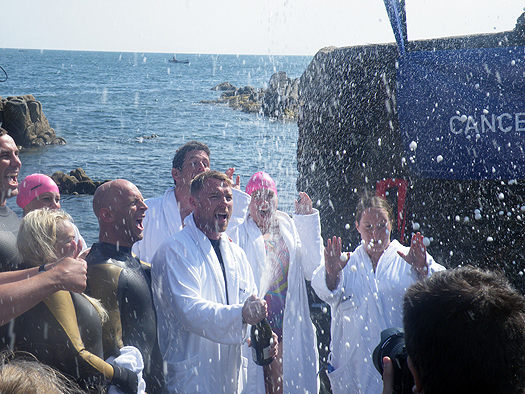
Ronan Keating Celebrates in Sandycove yesterday. Photo: Jehan Ashmore
Captain of The Samsung Galaxy S II Swim, Ronan Keating, said: "I can't believe we finally made it to Ireland. Fifty six miles later it's an incredible achievement and I'm so proud of the team. You can still sponsor the team at www.virginmoneygiving.com/team/theswim."
Steve Parry, first to touch land this morning, said: "I've been swimming for the majority of my life and The Swim has been the biggest challenge of my life. It's been a fantastic team of open water swimmers and adventurous celebrities who have come together for an amazing challenge to raise £1million for Cancer Research UK's life-saving work."
Two members of the public swam with the celebrity team across the Irish Sea. The two lucky swimmers were picked from a host of people who signed themselves up for swimming trials in Brighton in August. Olly White (33 year old teacher from Devon) and Nikki Fraser (18 year old student from Yorkshire), are both keen open water swimmers and were invaluable members of The Swim team.
After touching down at the north pier in Wicklow Bay the team are now back on the boat and making their way to the Forty Foot in Dunleary where they will get back in the water and swim to land for a second time this morning to greet their friends and family who are waiting anxiously for them on the shore.
For more information on The Swim or to sponsor the team, please visit www.the-swim.co.uk
Lifeguarding in Ireland
It might be hard to believe it but there is plenty of work here in Ireland for the professional lifeguard, from working in a leisure centre swimming pool, to the beautiful beaches around the coast and a beach lifeguard is needed to attain a surf coach qualification according to Muirtí Ó Cearnaigh of Atlantic Coast Lifeguards.
There are slight variations in the qualifications and experience needed to work in both these industries. A lot of people think a lifeguard is a person who is there to save lifes in the event of an accident happening but in actual fact they are there to prevent the incident happening in the first instance. With this they learn about every hazard and risk that is in their particular enviroment and the prevention methods needed to provide safety to the public.
They also learn techniques needed in the event of of actually preforming a rescue, which will include the use of communication with public and casualty, working in a team enviroment, rescue equipment, how to work well with other emergency services, life support, first aid and also train hard in terms of personal fitness.
When you are deciding whether to become a pool lifeguard or beach lifeguard, it really depends on your personal swimming abilty, a pool is a closed enviroment so there is minimum swimming required, where as the beach is a open enviroment so a strong fitness level in swimming is required.
There are two organisations in Ireland in which you can turn to to aquire the certification needed to work in either industry. Institute of Qualified Lifeguards Ireland (Lifeguards Ireland) which receive certification form Royal lifesaving soceity which is endoresed by the international lifesaving federation. And Irish Water Safety which have a very strong youth training programme set out in most counties.
When looking for certification look for out the (NPLQ) National Pool Lifeguard Qualification or (NBLQ) National Beach Lifeguard Qualification, you can find full information on both of these on www.atlanticcoastlifeguards.com where you can also find up and coming courses and any pre requisits needed for each.
Also check out www.lifeguardsireland.com & www.iws.ie for information on other lifesaving or lifeguarding courses nationwide.
Reasons why we think you will want to become a lifeguard:
• First and foremost you are providing an amazing public service. You will without a doubt make people feel confident, happier and safer just by being on the poolside and you could potentially save a life.
• Being a lifeguard offers a fantastic foundation to a career in the leisure industry. Many senior managers began their rise to leisure stardom by lifeguarding at their local pools
• The opportunity to get fit. Not only will you have to have a basic level of fitness to become a lifeguard but you will be encouraged to stay fit and get fitter. Many pools will give their lifeguards discounted or even free memberships.
• You get to work with a team of young like minded people, so there's plenty of opportunity to increase your social circle!
• The hours are flexible and perfect for those of you who need to fit studying into your busy days
• If you're a competitive type there is plenty of opportunity to show off your lifeguarding talents in events like the National Pool Lifeguard Championships (team event) and the Lifeguard Triathlon
• If you find you really enjoy lifeguarding you can take it up as a competitive sport and compete regularly for your local club.
• Lastly but still very importantly, you will gain a life skill that will come in handy for the rest of your life.





























